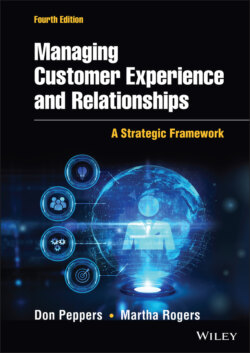Читать книгу Managing Customer Experience and Relationships - Don Peppers - Страница 28
THE TECHNOLOGY REVOLUTION AND THE CUSTOMER REVOLUTION
ОглавлениеOrganizations have accelerated their customer-focused strategies during the last few years, but managing customer relationships has been a business discipline for many years, since long before the era of mass marketing and mass media. Before the Industrial Revolution, and before mass production was born, merchants established their businesses around keeping customers.
Small towns typically had a general store, a local bank, and a barbershop. Each proprietor knew each one of their customers individually. The bank teller, for example, knew that Mr. Johnson cashed his paycheck each Friday afternoon. When Mr. Johnson came into the bank, the bank teller already had his cash ready for him in twenties and tens, just as he liked it. If Mr. Johnson unexpectedly stopped cashing his paycheck at the bank, the teller would not wonder why check-cashing service usage was dropping in the bank, but rather would wonder what had happened to Mr. Johnson. In short, the bank depended on the relationship with the individual customer and how much the people who worked for the bank knew about that customer. The teller's memory in this example is akin to today's data warehouses, which can store millions of data points, transaction histories, and characteristics about customers. Personal memory enabled the teller to fulfill each customer's individual banking needs and, ultimately, to build a profitable relationship with each one. The more the teller knew about a customer, the more convenient banking was for that customer—and the more likely the customer would continue to use the bank.
But during the past century, as enterprises sought to acquire as many customers as they possibly could, the local proprietor's influence over customer purchases decreased. Store owners or managers became little more than order takers, stocking their shelves with the goods that consumers would see advertised in the local newspaper or on television and radio. Mass-media advertising became a more effective way to publicize a product and generate transactions for a wide audience. But now technology has made it possible, and therefore competitively necessary, for enterprises to behave, once again, like small-town proprietors and deal with their customers individually, one customer at a time.
Treat different customers differently.
At the same time, technology has generated a business model that we will refer to as the trust platform.6 Becoming more and more prominent since the last edition of this book, trust platforms are epitomized by companies such as Uber, Airbnb, and Zipcar—and a host of others with brands that will always be in flux, but durable in concept. This kind of business depends on using interactive technology to connect willing buyers with willing sellers, while relying on crowd-sourced feedback to ensure mutual trust. Rather than a sharing economy, trust platforms facilitate an initiative economy, based on the entrepreneurial initiatives of thousands of individuals, all seamlessly connected to the larger network.
We must note that social interactions are not as manageable as a company's marketing and other functions are. The social interactions a company has with customers and other people can't be directed the same way advertising campaigns or cost-cutting initiatives can. Instead, in the e-social world, what companies are likely to find is that top-down, command-and-control organizations are not trustable, while self-organized collections of employees and partners motivated by a common purpose and socially empowered to take action are more trustable. (We'll address the distinction between trustability and trustworthiness in Chapter 3.)
